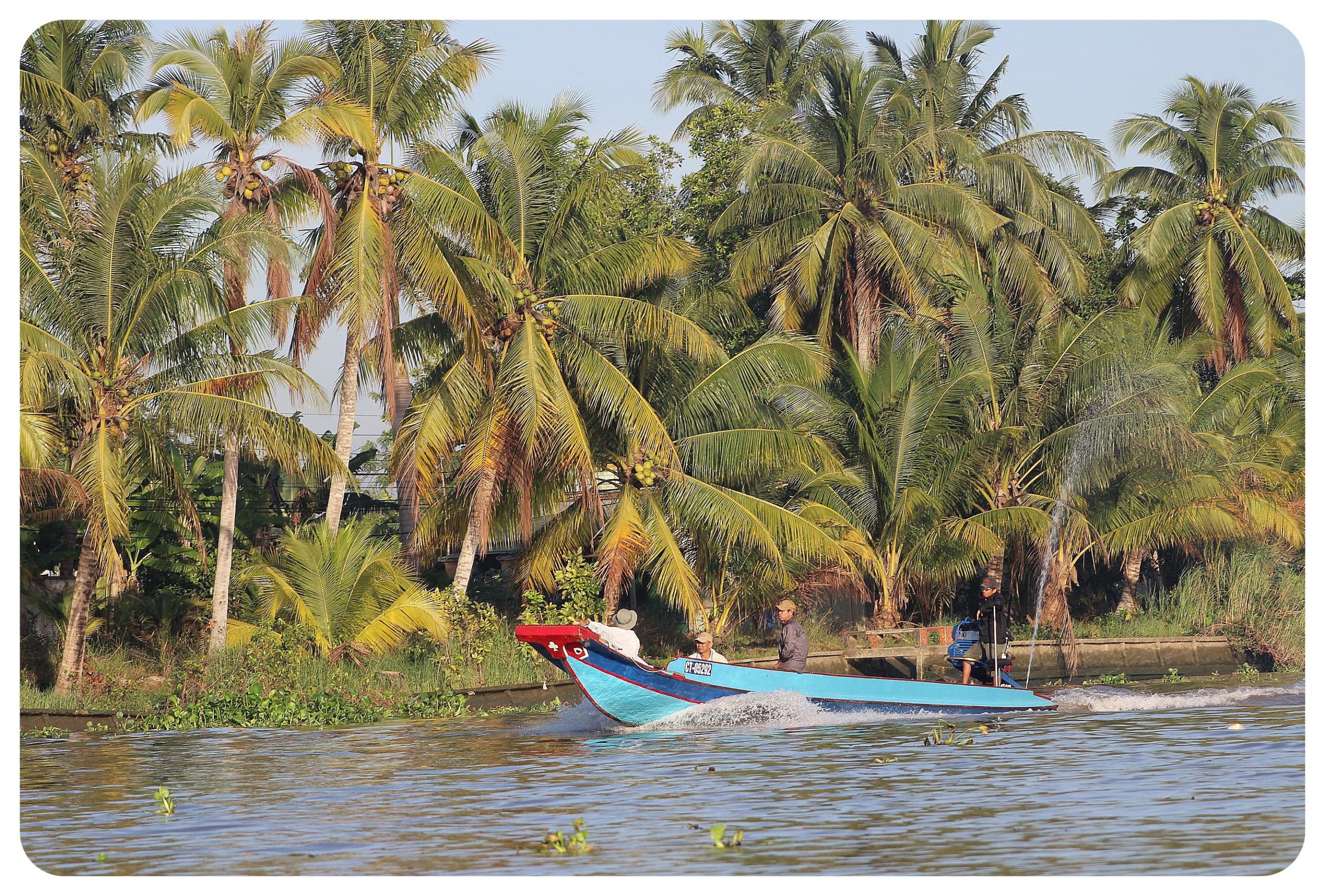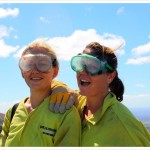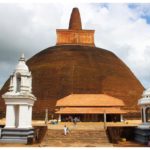Last Updated on March 6, 2025
When I tried to figure out my Vietnam itinerary, I had only a vague idea of the places I wanted to see, but visiting the Mekong Delta was one of the things that I knew I had to do – in fact, it was one of the things I was looking forward to the most. I am drawn to life on the water and life by the water, and the Mekong Delta sounded like a place of my liking: slow life on the river in a tropical setting. Floating markets, floating homes, laid back country life in a region that was fed by the many arteries of one of the largest rivers in the world. The Mekong runs through 6 countries in total: China, Laos, Myanmar, Thailand, Cambodia, and Vietnam, and the Mekong Delta is the main supplier of tropical fruits (70%) and the major producer and exporter of rice (60%) in the entire country.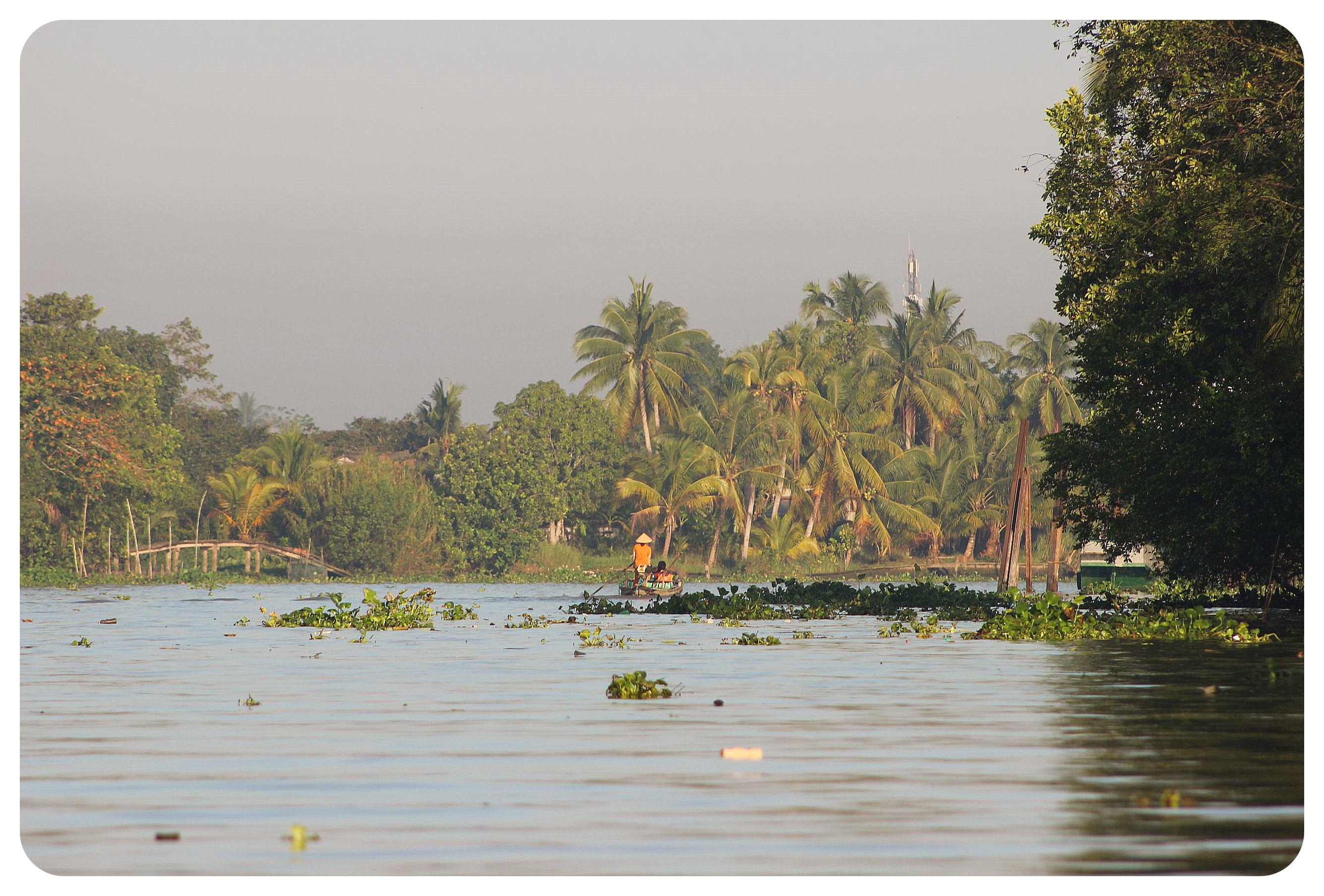 There are several ways to visit the Mekong Delta, which I’ll talk about in more detail at the end of the article, but I knew that I didn’t just want to get a glimpse of the Mekong Delta on a day trip from Ho Chi Minh City – I wanted to get a good feel for the region and visit several places.
There are several ways to visit the Mekong Delta, which I’ll talk about in more detail at the end of the article, but I knew that I didn’t just want to get a glimpse of the Mekong Delta on a day trip from Ho Chi Minh City – I wanted to get a good feel for the region and visit several places. I started in Can Tho, the main commercial hub of the region, and with a population of nearly 1.6 million, definitely not one of the small charming riverside towns I had pictured in my mind. The main reason for my stop here was the fact that Can Tho is a popular jumping-off point for boat rides to the Floating Markets. The floating markets are something unique to this region, and I wanted to experience at least one of them.
I started in Can Tho, the main commercial hub of the region, and with a population of nearly 1.6 million, definitely not one of the small charming riverside towns I had pictured in my mind. The main reason for my stop here was the fact that Can Tho is a popular jumping-off point for boat rides to the Floating Markets. The floating markets are something unique to this region, and I wanted to experience at least one of them. The first thing I did upon arriving in Can Tho was trying to find a boat tour to the floating market in Cai Rang, which is the largest floating market in the area and on most traveler’s “to do list” when they visit the Mekong Delta. Since it is also known to be quite touristy, I expected there to be a bunch of tours easily available, but I couldn’t find a tour that sounded amazing, which is why I ended up booking a boat tour through Airbnb Experiences (the tour I took isn’t available on the website anymore, but check out other Airbnb Experiences in Can Tho here). I was booked on a boat tour the next morning at 5.30am – the floating markets start around dawn and finish in the early morning, before it gets too hot.
The first thing I did upon arriving in Can Tho was trying to find a boat tour to the floating market in Cai Rang, which is the largest floating market in the area and on most traveler’s “to do list” when they visit the Mekong Delta. Since it is also known to be quite touristy, I expected there to be a bunch of tours easily available, but I couldn’t find a tour that sounded amazing, which is why I ended up booking a boat tour through Airbnb Experiences (the tour I took isn’t available on the website anymore, but check out other Airbnb Experiences in Can Tho here). I was booked on a boat tour the next morning at 5.30am – the floating markets start around dawn and finish in the early morning, before it gets too hot.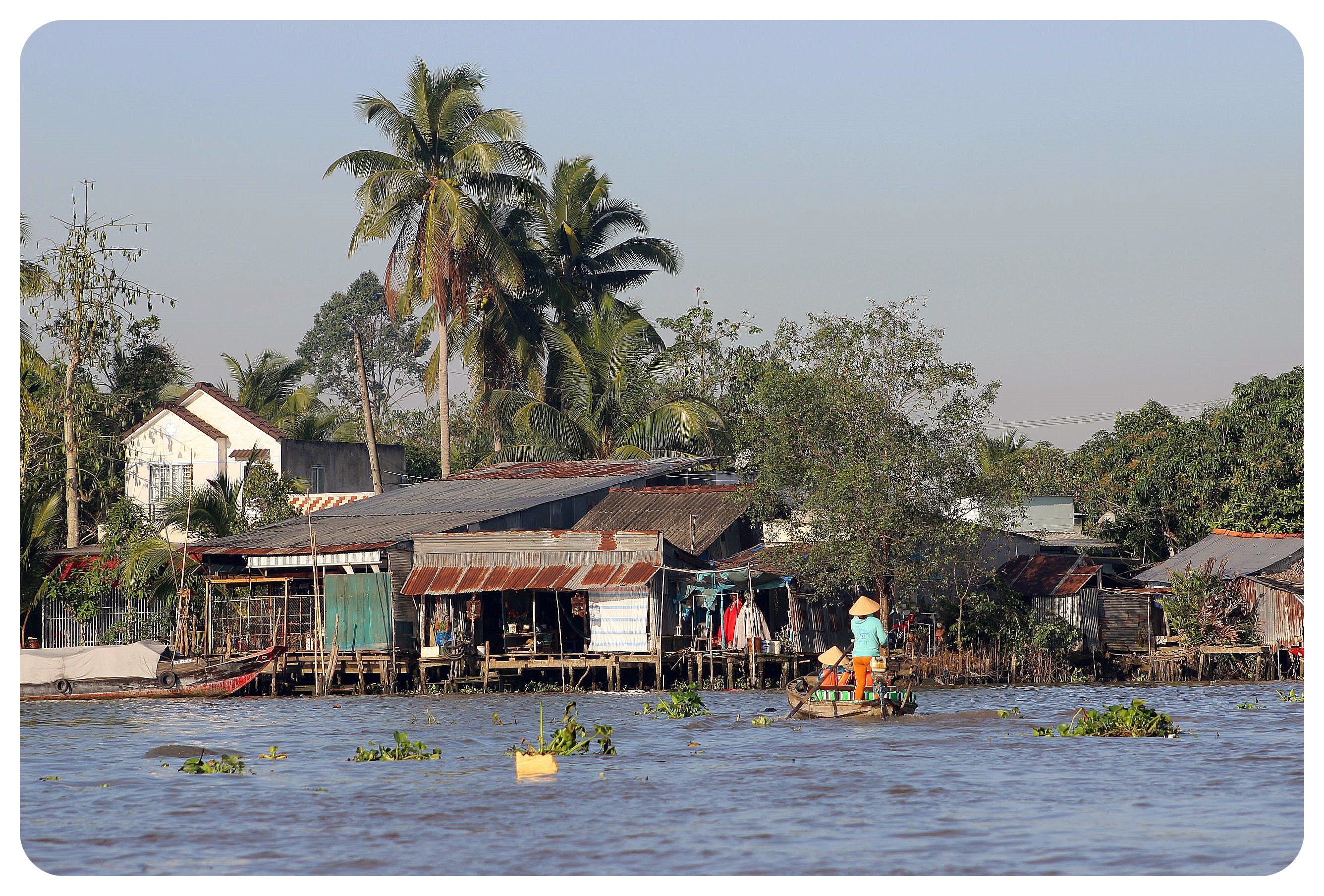 I was up bright and early and surprised when I was the only one showing up at the meeting point – I expected there to be other people, but it was just me. My driver introduced himself and led me to a small wooden boat, in which I’d spend the next few hours.
I was up bright and early and surprised when I was the only one showing up at the meeting point – I expected there to be other people, but it was just me. My driver introduced himself and led me to a small wooden boat, in which I’d spend the next few hours. We didn’t waste any time and went up the river right away, just as the sun was starting to rise behind the horizon. It was a beautiful way to start the day, even grumpy not-a-morning-person me had to admit that. As we left the lights of the city behind us, it got even more beautiful. Coconuts lined the shores of the Can Tho River on both sides, the color of the sky changed every few minutes, as the sun rose higher, displaying a beautiful array of colors.
We didn’t waste any time and went up the river right away, just as the sun was starting to rise behind the horizon. It was a beautiful way to start the day, even grumpy not-a-morning-person me had to admit that. As we left the lights of the city behind us, it got even more beautiful. Coconuts lined the shores of the Can Tho River on both sides, the color of the sky changed every few minutes, as the sun rose higher, displaying a beautiful array of colors. We arrived at Cai Rang market, which is about four miles southwest of Can Tho, around 6.30am, and the area of the river on which the market took place was filled with boats: larger barges that were packed with pineapples, bananas and pumpkins, and smaller boats that were buying produce in large quantities for their local markets.
We arrived at Cai Rang market, which is about four miles southwest of Can Tho, around 6.30am, and the area of the river on which the market took place was filled with boats: larger barges that were packed with pineapples, bananas and pumpkins, and smaller boats that were buying produce in large quantities for their local markets.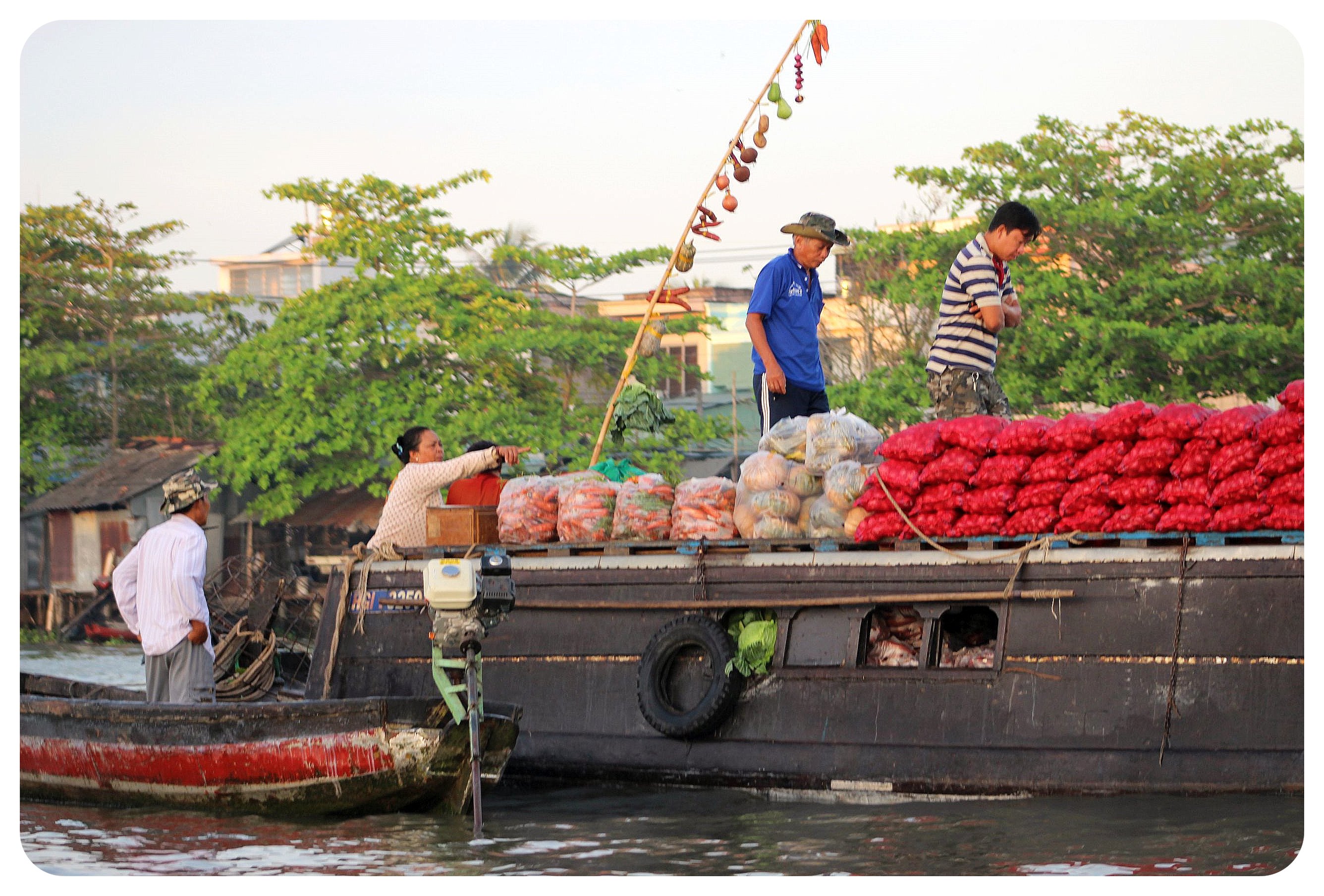 Many of the small boats that visit the market come from communities in the Mekong Delta that don’t have access to larger roads because they’re surrounded by many small arteries of the Mekong River, making it impossible to receive large deliveries by truck. Everything they need for their daily lives is delivered by boat.
Many of the small boats that visit the market come from communities in the Mekong Delta that don’t have access to larger roads because they’re surrounded by many small arteries of the Mekong River, making it impossible to receive large deliveries by truck. Everything they need for their daily lives is delivered by boat. Everyone at the market was much more awake than I was at this ungodly hour which is why I happily agreed when a floating coffee vendor motioned to me if I wanted a cup. She maneuvered her boat right next to ours and handed me a small, hot coffee – served in a small plastic cup. It still baffles me that hot coffee is served in plastic cups in a lot of places, but I was grateful for the caffeine buzz.
Everyone at the market was much more awake than I was at this ungodly hour which is why I happily agreed when a floating coffee vendor motioned to me if I wanted a cup. She maneuvered her boat right next to ours and handed me a small, hot coffee – served in a small plastic cup. It still baffles me that hot coffee is served in plastic cups in a lot of places, but I was grateful for the caffeine buzz.
There aren’t just coffee vendors serving both visitors and markets vendors: there was a boat offering banh mi sandwiches, another boat with soups, and a guy making he rounds with soft drinks. As it got lighter, the market got busier. Other tourist boats appeared, and when I saw large groups of tourists squeezed in small boats, I started to appreciate my private ride – choosing the right tour can make a big difference when you visit the Mekong Delta (see below).
As it got lighter, the market got busier. Other tourist boats appeared, and when I saw large groups of tourists squeezed in small boats, I started to appreciate my private ride – choosing the right tour can make a big difference when you visit the Mekong Delta (see below).
Observing the market was fascinating. I love markets and visit markets all over the world, and while most markets, no matter if they are in South East Asia or across the globe in Latin America, are pretty similar, a floating market is completely different. The logistics of getting goods from one boat to another, to dock the boat close enough to the barge they are buying from, trying to make sure that the goods are fresh – it all comes with unique challenges. However, the vendors here have been dealing with these challenges for decades, and what looks complicated to me as an outsider is what they have been doing their entire lives. In fact, they don’t know it any other way.
However, the vendors here have been dealing with these challenges for decades, and what looks complicated to me as an outsider is what they have been doing their entire lives. In fact, they don’t know it any other way.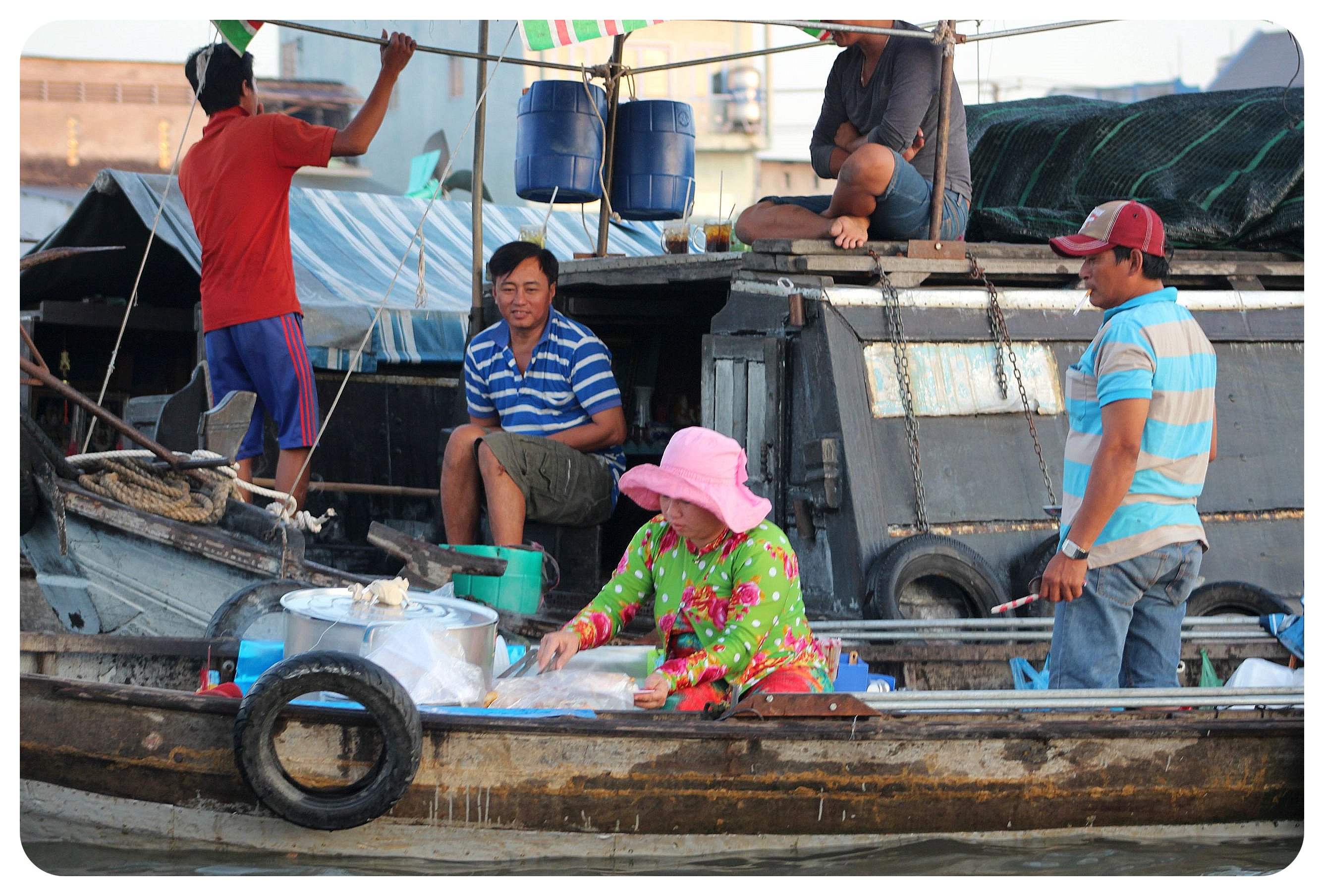 In this part of Vietnam, a lot of villages along the Mekong arteries don’t have access to larger market towns because of a lack of bridges – even though several bridges have been built over the past few years – and these villages get their goods and fresh produce from floating vendors who go up and down the river with their goods.
In this part of Vietnam, a lot of villages along the Mekong arteries don’t have access to larger market towns because of a lack of bridges – even though several bridges have been built over the past few years – and these villages get their goods and fresh produce from floating vendors who go up and down the river with their goods.
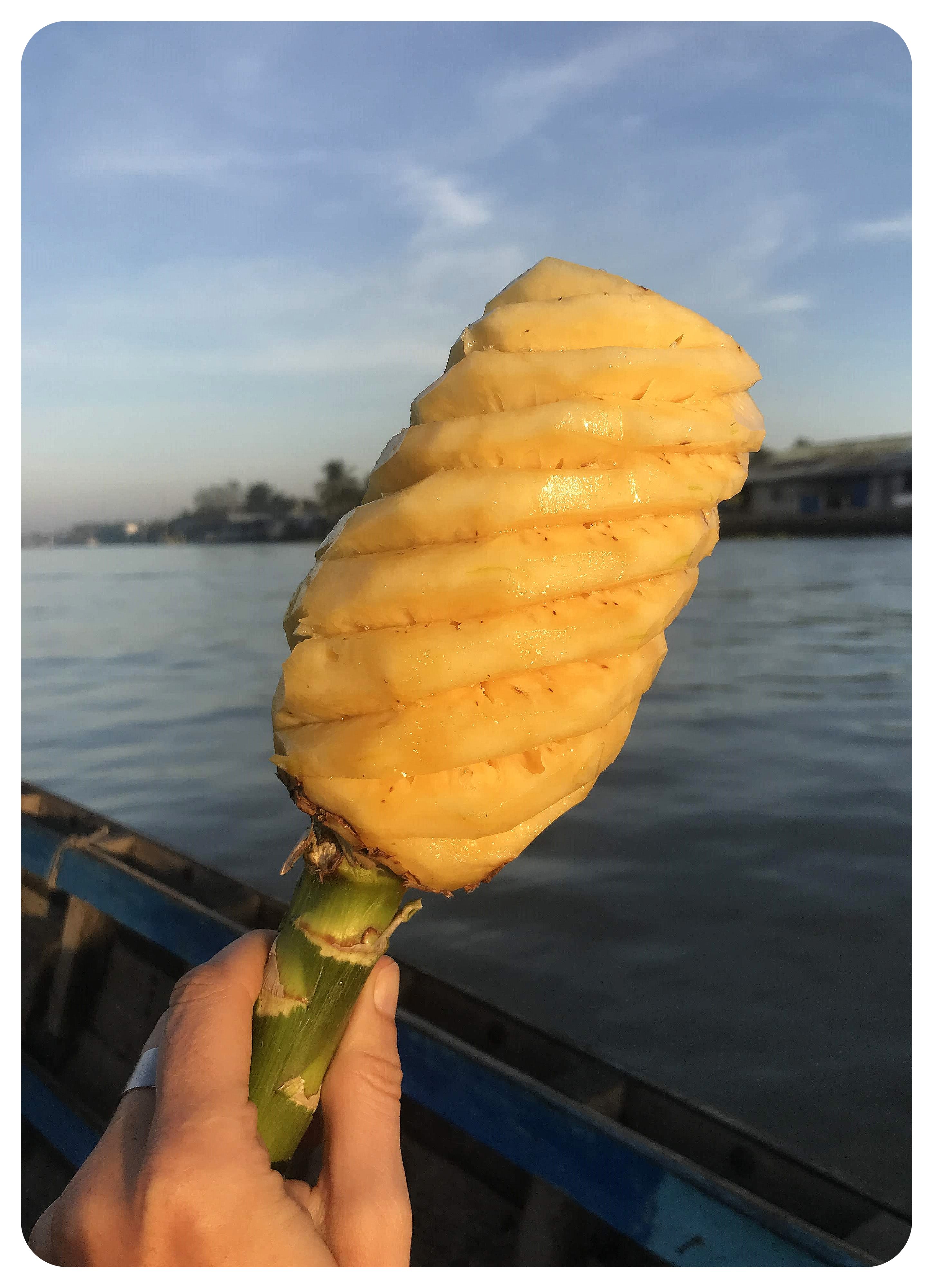 While I was people watching, my driver bought a pineapple which he skillfully carved out for me – in my eyes, the perfect breakfast!
While I was people watching, my driver bought a pineapple which he skillfully carved out for me – in my eyes, the perfect breakfast!
After lingering at the market for a while, my boat driver headed further south on the river. Another advantage of the private tour I booked is that I got to see another floating market that is not visited by many group tours, and I also got to take in more life on the river.
Our first stop, just north of Cai Rang market, is a gas station, and just like at any other gas station, we get in line. Only that this line is formed by boats, not cars. Fueled up, we went further down the river, and it was fascinating to watch the river wake up and come to life. I saw people meditate outside their houses, shower, brush their teeth, or eat a bowl of soup.
Fueled up, we went further down the river, and it was fascinating to watch the river wake up and come to life. I saw people meditate outside their houses, shower, brush their teeth, or eat a bowl of soup.
Most people had clothing racks outside their houses, and most of the houses sit on stilts. There was one house that was held up by a retired boat. Houses often miss walls, or they are held together by corrugated tin. Bamboo stilts are ubiquitous, used to hold up anything from laundry and roofs to power lines. Many houses aren’t much more than little shacks, some of them wide open towards the river, allowing people who glide by in a boat to catch a glimpse of their home furnishings and daily rituals.
There was one house that was held up by a retired boat. Houses often miss walls, or they are held together by corrugated tin. Bamboo stilts are ubiquitous, used to hold up anything from laundry and roofs to power lines. Many houses aren’t much more than little shacks, some of them wide open towards the river, allowing people who glide by in a boat to catch a glimpse of their home furnishings and daily rituals.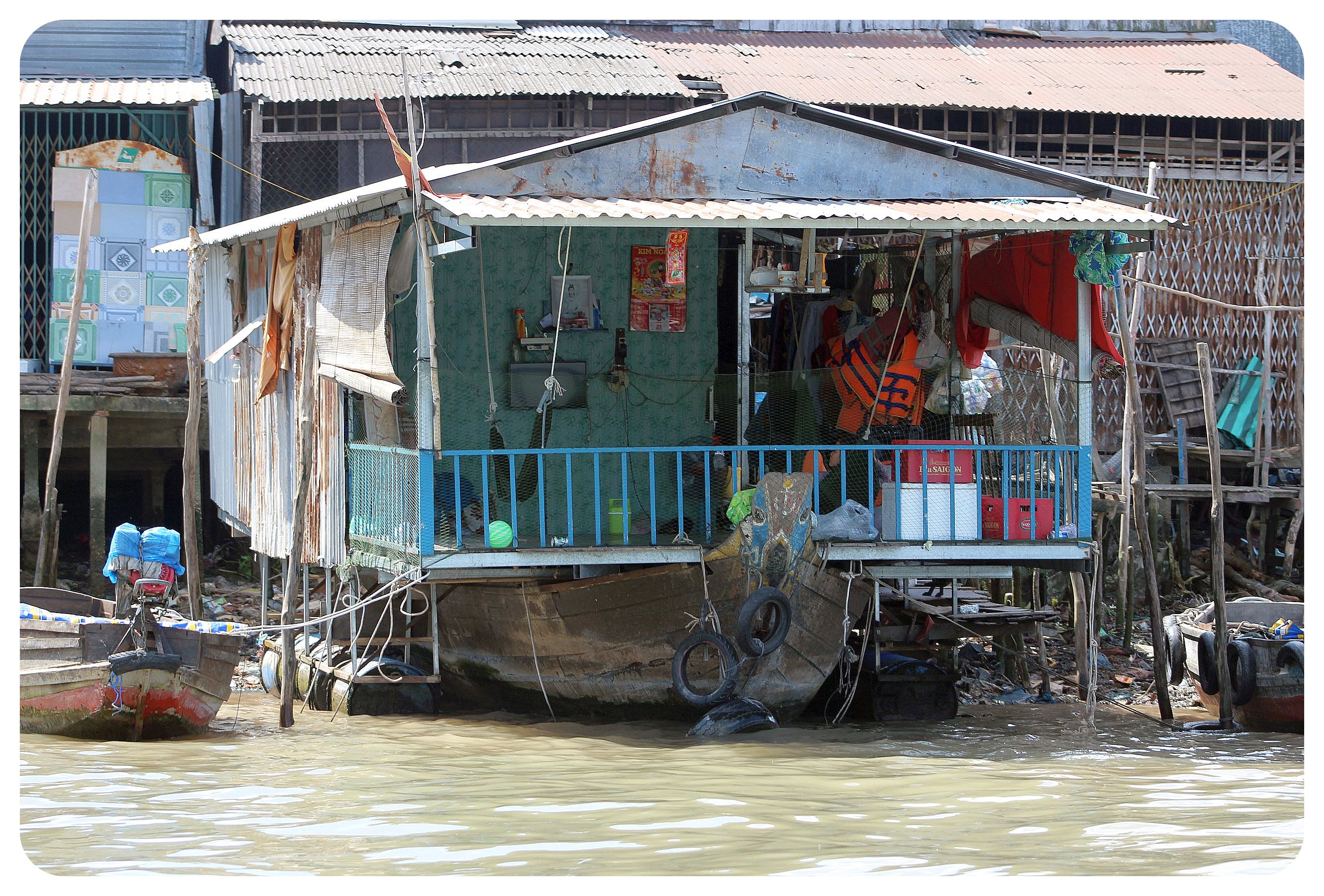 Every family that lives by the water has a boat. For many, it is the only way to get around. I saw school kids being brought to school in a boat by their mom. Couples were bringing back groceries on their boat. Some floating vendors don’t sell at markets, but go from house to house offering their goods – I guess that’s the Mekong Delta version of grocery delivery?
Every family that lives by the water has a boat. For many, it is the only way to get around. I saw school kids being brought to school in a boat by their mom. Couples were bringing back groceries on their boat. Some floating vendors don’t sell at markets, but go from house to house offering their goods – I guess that’s the Mekong Delta version of grocery delivery? I watched people transport fruits and vegetables to sell them at a floating market. It made me wonder if they appreciate their commute, which I consider so much more picturesque than the commute most of us have – subways, freeways, sitting in traffic jams.. – or if they see it as a hassle to have to use a boat to get anywhere.
I watched people transport fruits and vegetables to sell them at a floating market. It made me wonder if they appreciate their commute, which I consider so much more picturesque than the commute most of us have – subways, freeways, sitting in traffic jams.. – or if they see it as a hassle to have to use a boat to get anywhere. Because of the lack of bridges, every few miles, there is a ferry boat, which people use to get to the other side of the river. The ferry docks, about a dozen scooters drive onto the boat, the ferry crosses the river, and as soon as it docks on the other side, the scooters drive off and continue their commute.
Because of the lack of bridges, every few miles, there is a ferry boat, which people use to get to the other side of the river. The ferry docks, about a dozen scooters drive onto the boat, the ferry crosses the river, and as soon as it docks on the other side, the scooters drive off and continue their commute.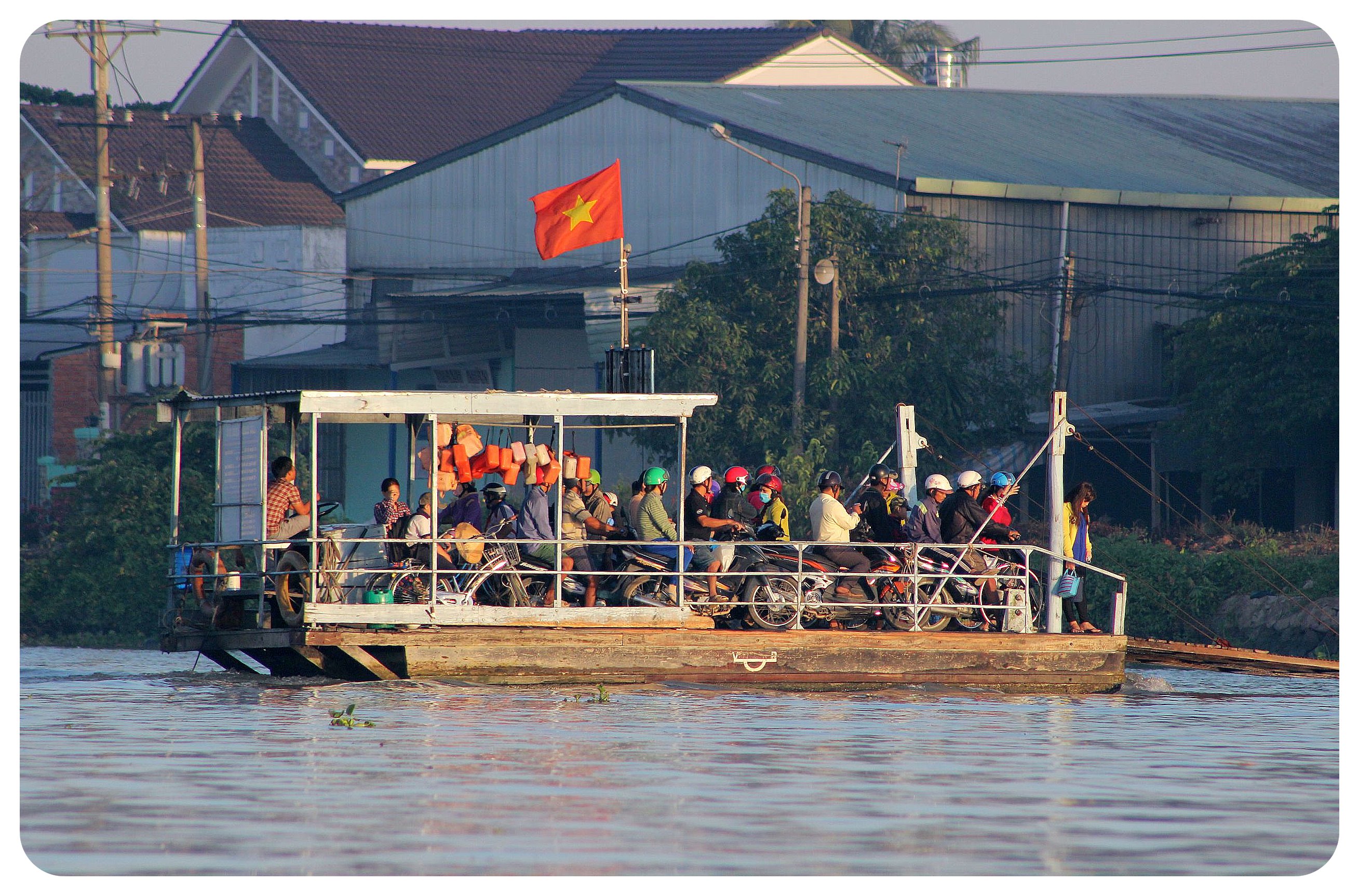 Occasionally, we passed a house that had been claimed by the river.
Occasionally, we passed a house that had been claimed by the river. One thing I noticed was that garbage is a big issue here. It seemed like most people disposed their garbage right into the river, or piled it up next to their houses. But without roads, there aren’t any garbage trucks coming by to pick up the trash.
One thing I noticed was that garbage is a big issue here. It seemed like most people disposed their garbage right into the river, or piled it up next to their houses. But without roads, there aren’t any garbage trucks coming by to pick up the trash. An hour later, we arrive at Phong Dien Floating Market. Right away I noticed a big difference to the market in Cai Rang: there weren’t any large barges here. Instead, the vendors here arrive in small stand-up rowing boats and sell mainly fresh fruits and vegetables from their community.
An hour later, we arrive at Phong Dien Floating Market. Right away I noticed a big difference to the market in Cai Rang: there weren’t any large barges here. Instead, the vendors here arrive in small stand-up rowing boats and sell mainly fresh fruits and vegetables from their community.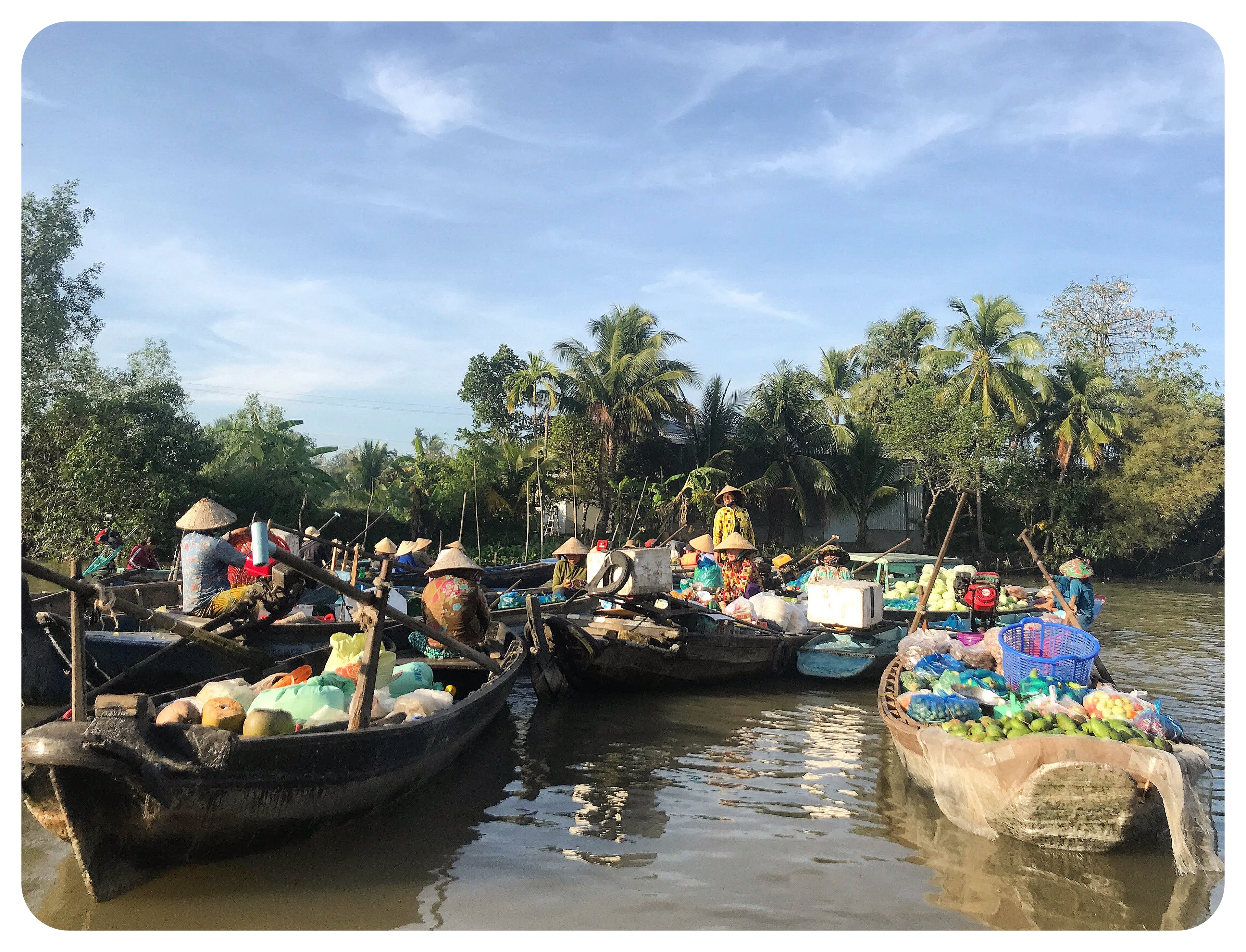 Almost all the vendors in Phong Dieng were women. Some of the boats were filled with a variety of fruits and vegetables, others offered only one: I spotted a boat loaded with cabbage, and another one filled to the brim with pineapples.
Almost all the vendors in Phong Dieng were women. Some of the boats were filled with a variety of fruits and vegetables, others offered only one: I spotted a boat loaded with cabbage, and another one filled to the brim with pineapples. The atmosphere here felt much more relaxed. In Cai Rang, there was a lot more noise. The loud motors of the larger boats, people yelling, tourists.
The atmosphere here felt much more relaxed. In Cai Rang, there was a lot more noise. The loud motors of the larger boats, people yelling, tourists.
Here, I felt like I was watching an intimate gathering of local women who get together to chat, joke and have a coffee – all while stocking up on things they need and selling produce off their land. This market was also considerably smaller than the Cai Rang Floating Market, but don’t think you’ll have it all to yourself: some tourist boats make it all the way down to Phong Dien.
This market was also considerably smaller than the Cai Rang Floating Market, but don’t think you’ll have it all to yourself: some tourist boats make it all the way down to Phong Dien.
After observing the market vendors for a while as they were haggling, inspecting the produce, and gossiping, I motioned to my driver, who didn’t speak a single word of English, that I was ready to move on.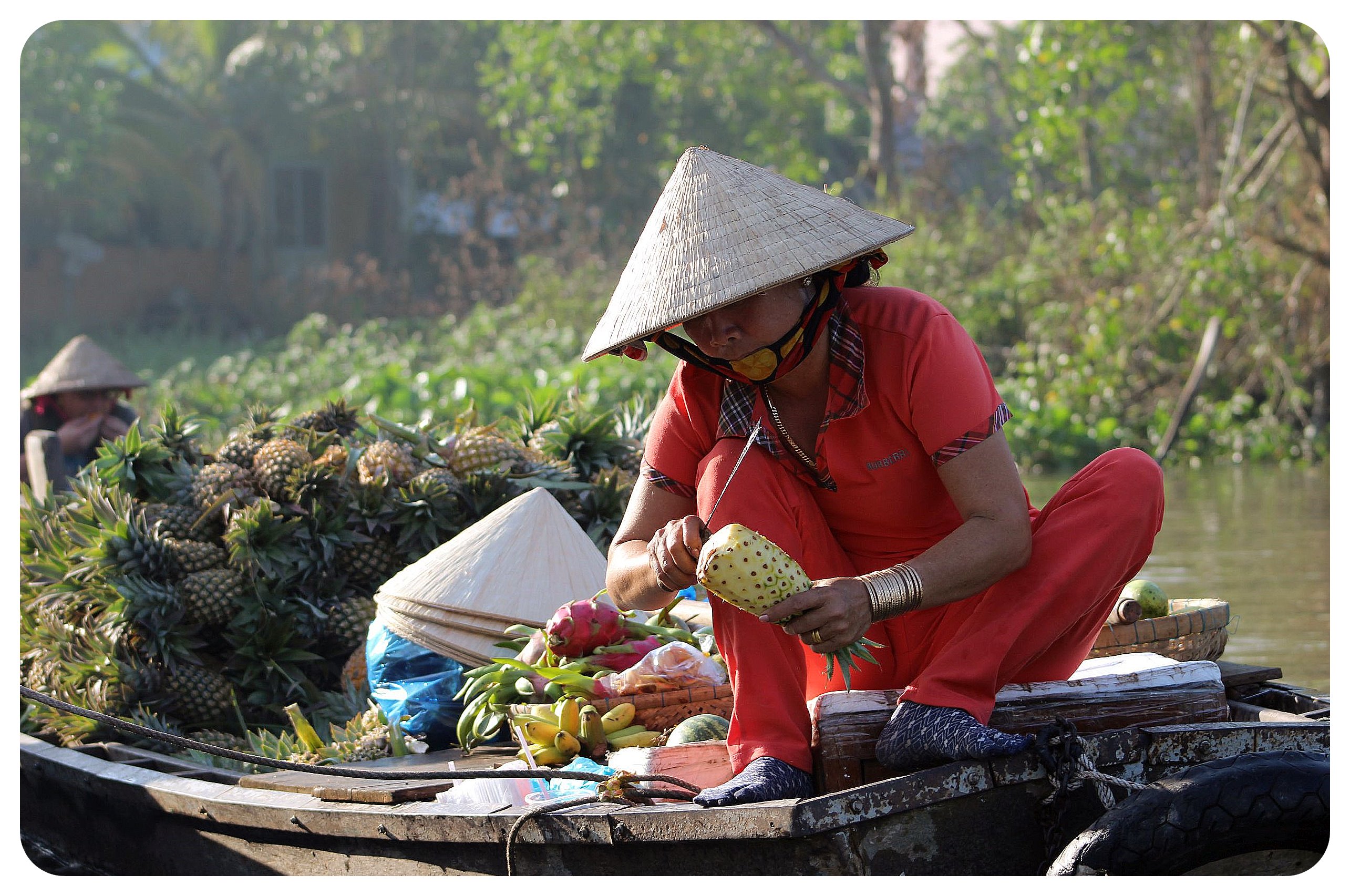 We were about halfway through the 6-hour tour, and I wondered what else I’d get to see, because the boat was turning around, and we headed back the same way we came. But after a while, the boat slowed down and he turned into a little side canal off the Can Tho River.
We were about halfway through the 6-hour tour, and I wondered what else I’d get to see, because the boat was turning around, and we headed back the same way we came. But after a while, the boat slowed down and he turned into a little side canal off the Can Tho River. Away from the main river, it was so tranquil and the trees that were growing on both sides of the canal formed a natural leaf roof over the water. It was beautiful.
Away from the main river, it was so tranquil and the trees that were growing on both sides of the canal formed a natural leaf roof over the water. It was beautiful.
We stopped at a small pier where he told me to get out of the boat. “Breakfast”, he said, and pointed towards a restaurant with a large palm tree filled garden. This was the part of the tour that I found a little annoying, because I was told by the waiter, who spoke better English, that I had to buy breakfast for me and for my driver and the prices at this restaurant were definitely inflated for tourists. Another sign that this place was exclusively here for tourists was the fact that the menu was entirely in English, and there were photos of the dishes next to the names. My driver took a nap in one of the hammocks that were lining the courtyard while I was eating some spring rolls, and then we continued our tour through the canals – which reminded me a lot of the backwaters of Kerala in Southern India. A different continent, and yet a very similar life. People were bathing in the canals, washing laundry and dishes in the muddy waters – just as I’d seen them do it in Kerala.
My driver took a nap in one of the hammocks that were lining the courtyard while I was eating some spring rolls, and then we continued our tour through the canals – which reminded me a lot of the backwaters of Kerala in Southern India. A different continent, and yet a very similar life. People were bathing in the canals, washing laundry and dishes in the muddy waters – just as I’d seen them do it in Kerala.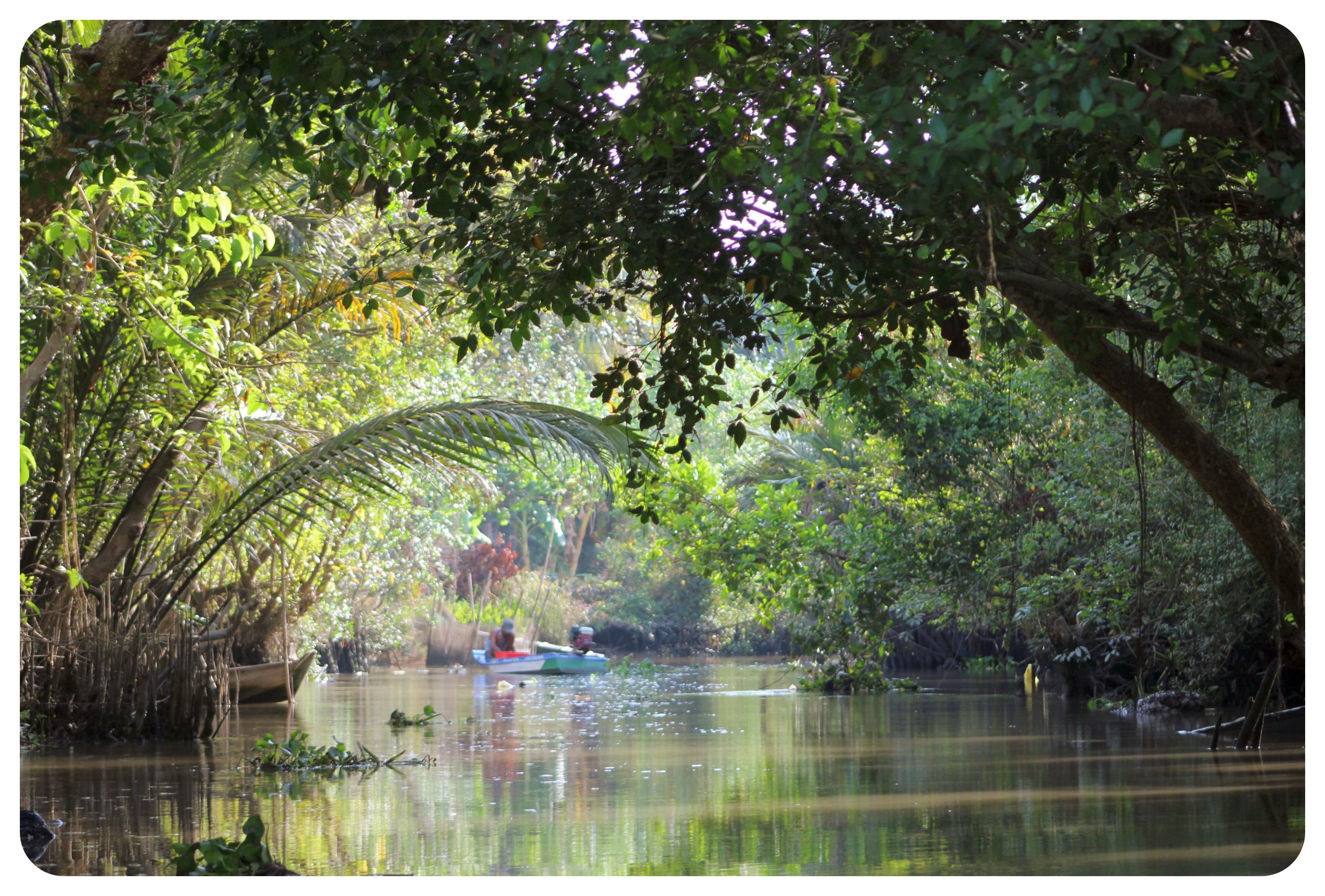 Before we returned onto the main river, my driver stopped the boat again and pointed at a large building right on the shore: a coconut candy factory. This was clearly a regular stop on all of the boat tours, because the place was packed with tourists – in fact, more tourists than I’d seen all day. It was a little bit too touristy for me, but in the end I walked out with a couple of coconut candy snacks, because who I am to turn down an opportunity to try some local candy?
Before we returned onto the main river, my driver stopped the boat again and pointed at a large building right on the shore: a coconut candy factory. This was clearly a regular stop on all of the boat tours, because the place was packed with tourists – in fact, more tourists than I’d seen all day. It was a little bit too touristy for me, but in the end I walked out with a couple of coconut candy snacks, because who I am to turn down an opportunity to try some local candy? After this stop, we made our way back to Can Tho, where we docked at 12.30pm. One might think that six hours in a boat sound like a lot, but the six hours flew by, and I really enjoyed my time on the river. This tour alone made my visit to the Mekong Delta, but I was eager to see more.
After this stop, we made our way back to Can Tho, where we docked at 12.30pm. One might think that six hours in a boat sound like a lot, but the six hours flew by, and I really enjoyed my time on the river. This tour alone made my visit to the Mekong Delta, but I was eager to see more.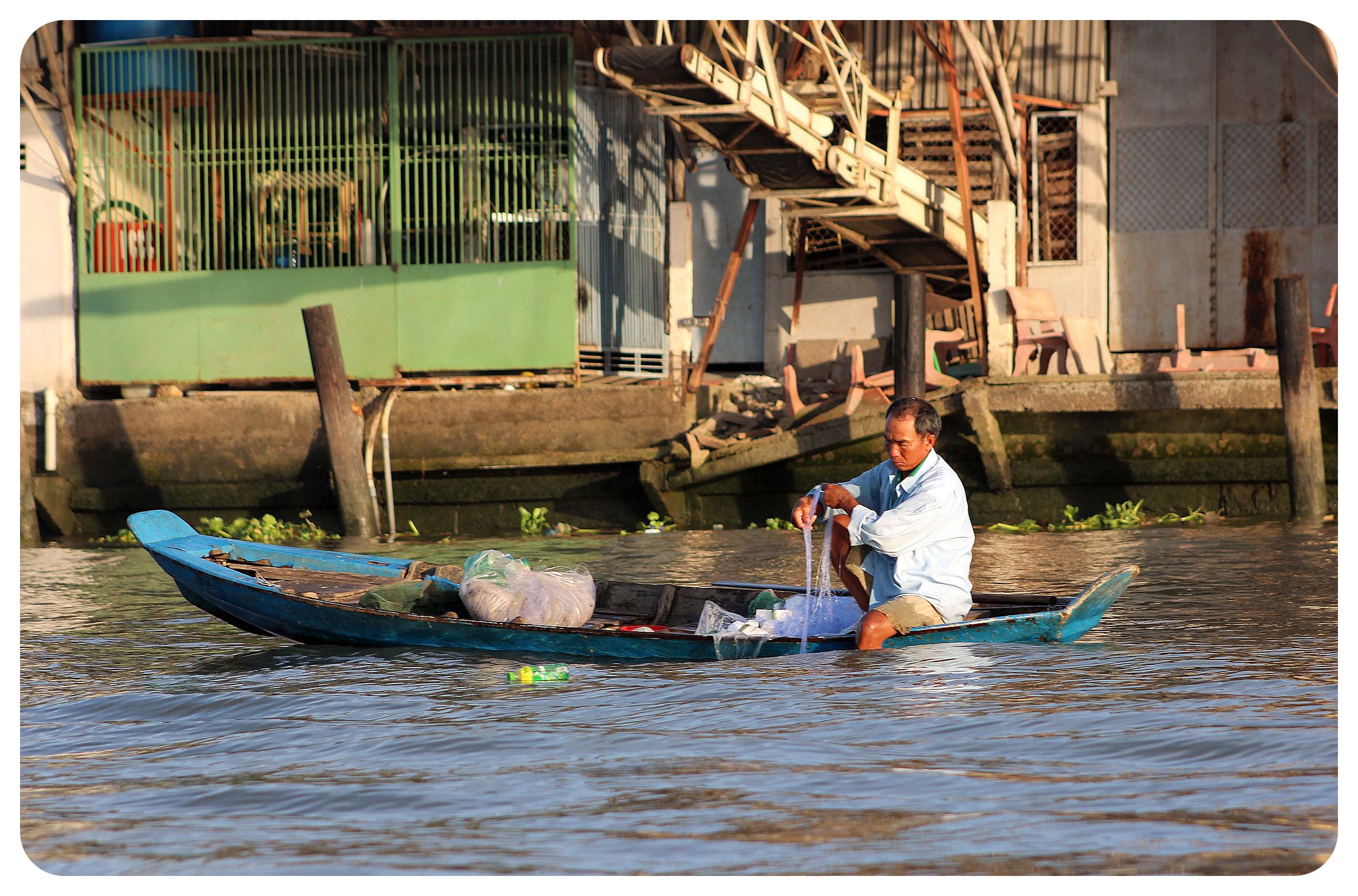 Walking back to my guesthouse, I noticed how different Can Tho felt once you got away from the river. I didn’t find the town particularly interesting, but I had decided to spend another day there to see a little bit more of the town, and while researching what there was to do in Can Tho I came across a “Pay What You Want” food tour. An interesting concept for a food tour, and since I was still familiarizing myself with all the different dishes in Vietnam, I signed up for it.
Walking back to my guesthouse, I noticed how different Can Tho felt once you got away from the river. I didn’t find the town particularly interesting, but I had decided to spend another day there to see a little bit more of the town, and while researching what there was to do in Can Tho I came across a “Pay What You Want” food tour. An interesting concept for a food tour, and since I was still familiarizing myself with all the different dishes in Vietnam, I signed up for it. The food tour turned out to be great (see bottom of the post for details) – especially considering the suggested donation at the end of the tour was only US$5! We had to pay for the food, but food is so cheap in Vietnam that my share of all the food we consumed was only VND200,000 (about US$8.50) – and that included to beers.
The food tour turned out to be great (see bottom of the post for details) – especially considering the suggested donation at the end of the tour was only US$5! We had to pay for the food, but food is so cheap in Vietnam that my share of all the food we consumed was only VND200,000 (about US$8.50) – and that included to beers.
We started with fresh spring rolls which had an interesting twist because green banana as well as pineapple were added to the more conventional ingredients like cucumber and carrots. The second stop included pork muffins (which I skipped), and then we had two dishes at the third stop: tofu and eggplant, both grilled over a hot flame. We washed down the food with some Vietnamese beer before we finished the night with sweet rice from a street vendor. The rice was mixed together with coconut milk and served in a rice waffle which was delicious. The rest of my time in Can Tho was spent wandering the streets of the city, but after a couple of days I was ready to move on. After experiencing life on the river, I wanted to get a little closer to life along the river – the little communities near the smaller distributaries that make up the Mekong Delta.
The rest of my time in Can Tho was spent wandering the streets of the city, but after a couple of days I was ready to move on. After experiencing life on the river, I wanted to get a little closer to life along the river – the little communities near the smaller distributaries that make up the Mekong Delta. I thought that a homestay, living with a local family for a couple of nights, would be the best way for me to get a better understanding of what it’s actually like to live in the Mekong Delta. I found a lovely family that hosts visitors in their home on the outskirts of Ben Tre, and the three days I spent there were fantastic.
I thought that a homestay, living with a local family for a couple of nights, would be the best way for me to get a better understanding of what it’s actually like to live in the Mekong Delta. I found a lovely family that hosts visitors in their home on the outskirts of Ben Tre, and the three days I spent there were fantastic.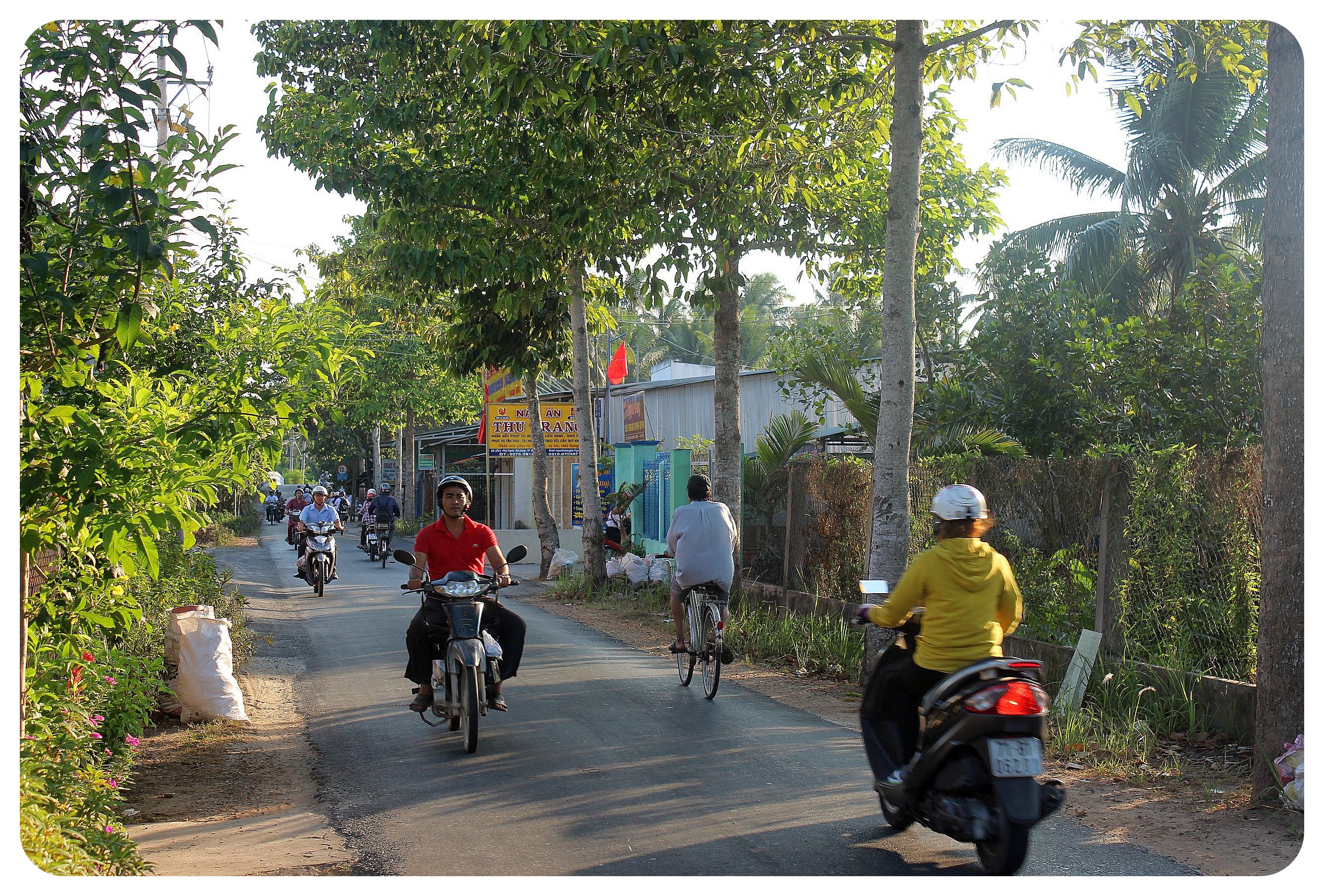 Included in the homestay was the use of the family’s bicycles and a simply breakfast of an omelet and baguette and traditional Vietnamese coffee, ca phe. For a ca phe, ground beans go into a French drip filter (called a phin), which sits on top of a glass (or cup), and hot water is added to the phin. The water slowly trickles through into the cup, resulting in a very strong coffee. Most people sweeten it with condensed milk, but I prefer it black.
Included in the homestay was the use of the family’s bicycles and a simply breakfast of an omelet and baguette and traditional Vietnamese coffee, ca phe. For a ca phe, ground beans go into a French drip filter (called a phin), which sits on top of a glass (or cup), and hot water is added to the phin. The water slowly trickles through into the cup, resulting in a very strong coffee. Most people sweeten it with condensed milk, but I prefer it black.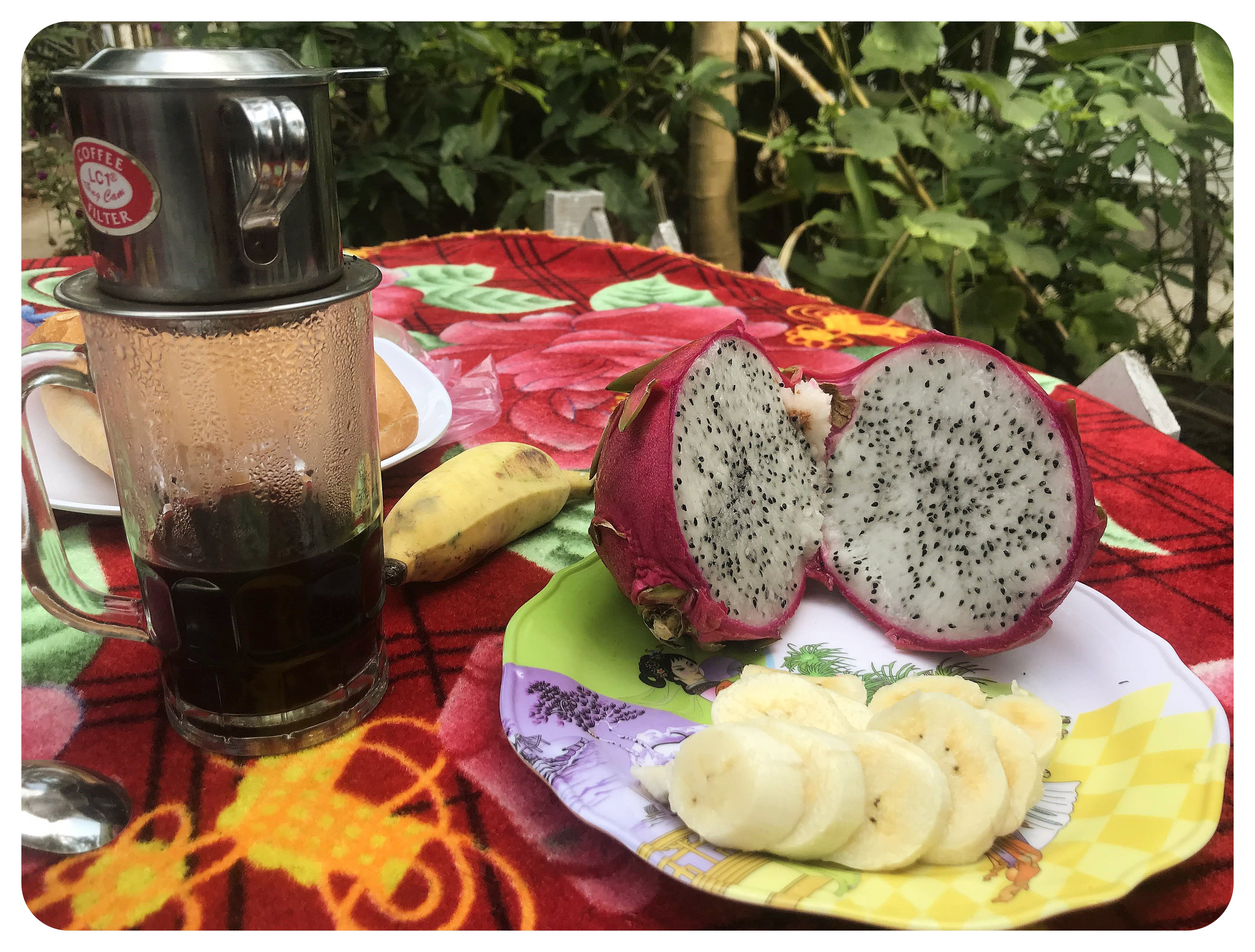 I pimped my breakfast by adding some dragon fruit and baby bananas from the local market and then took off on one of their rickety bikes, without a fixed destination, just a vague idea of smaller roads and paths I could follow to see more of the area.
I pimped my breakfast by adding some dragon fruit and baby bananas from the local market and then took off on one of their rickety bikes, without a fixed destination, just a vague idea of smaller roads and paths I could follow to see more of the area. I used GoogleMaps to have an idea where I was, but I just followed roads that looked interesting to me.
I used GoogleMaps to have an idea where I was, but I just followed roads that looked interesting to me.
It was an incredible experience to ride through little villages and along tiny canals, and the streets were so empty that I wasn’t afraid to cycle there. I passed dozens of coconut plantations and coconut factories (Ben Tre is famous for its coconut candies which are produced in massive quantities here), and watched coconut flakes drying on big sheets in front of small houses.
I passed dozens of coconut plantations and coconut factories (Ben Tre is famous for its coconut candies which are produced in massive quantities here), and watched coconut flakes drying on big sheets in front of small houses. I crossed countless little rivers and canals on wooden bridges, and every time someone passed me in a boat, they waved at me or said hello.
I crossed countless little rivers and canals on wooden bridges, and every time someone passed me in a boat, they waved at me or said hello. Everyone was extremely friendly, and I enjoyed the slower pace of life here. In Saigon, everyone always seems to be in a hurry – here, it was quite the opposite.
Everyone was extremely friendly, and I enjoyed the slower pace of life here. In Saigon, everyone always seems to be in a hurry – here, it was quite the opposite.
Every once in a while, I passed a small cemetery. I saw local markets and watched people put out fish and rice paper to dry out in the sun.
I saw local markets and watched people put out fish and rice paper to dry out in the sun.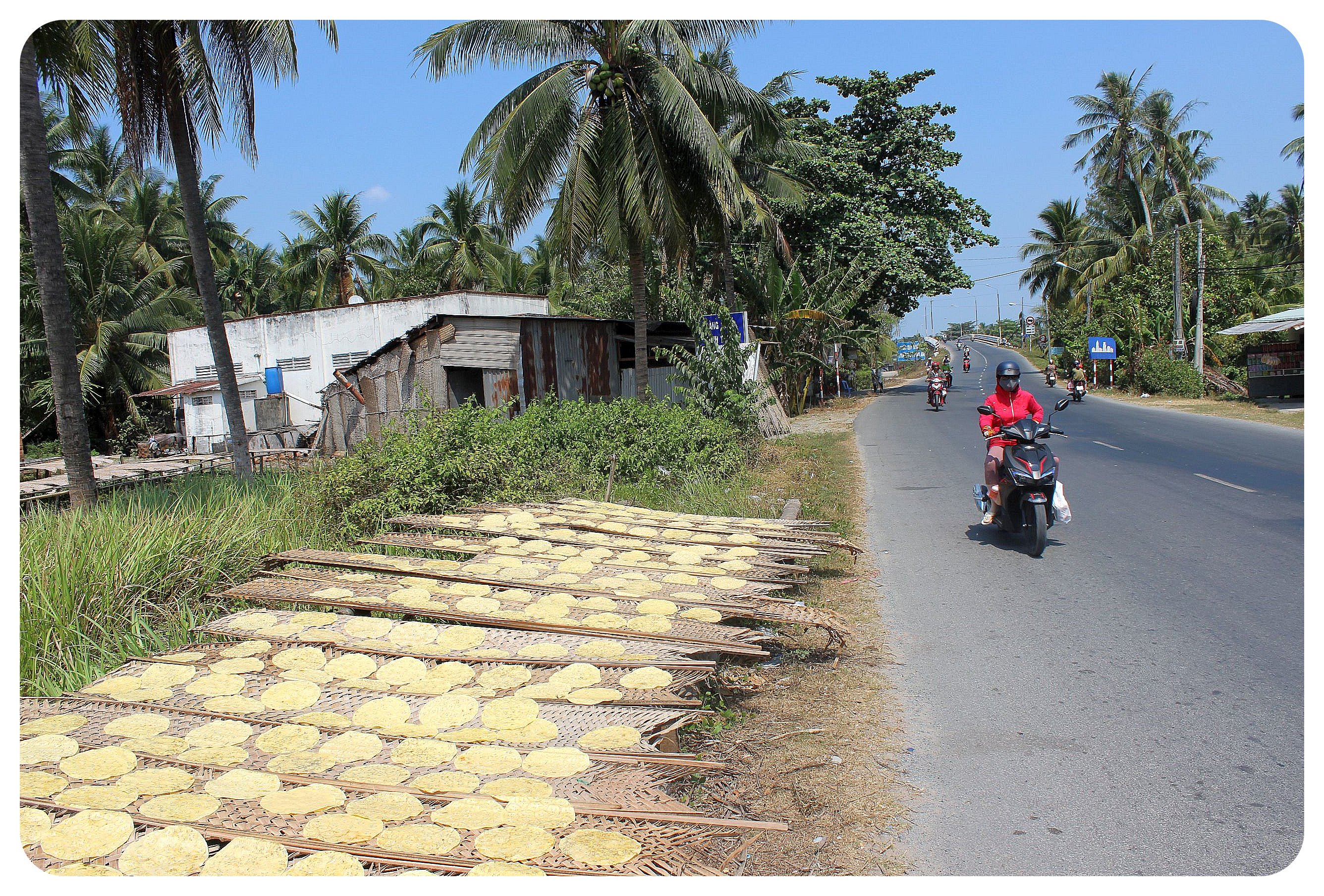 The best part of the day was the afternoon when school was out and I found myself surrounded by local children on bicycles that looked so old that I assumed their grandparents had already used them when they cycled to school. The kids were all eager to practice their English with the foreigner, yelling their “Hellos” and “How are you’s”.
The best part of the day was the afternoon when school was out and I found myself surrounded by local children on bicycles that looked so old that I assumed their grandparents had already used them when they cycled to school. The kids were all eager to practice their English with the foreigner, yelling their “Hellos” and “How are you’s”.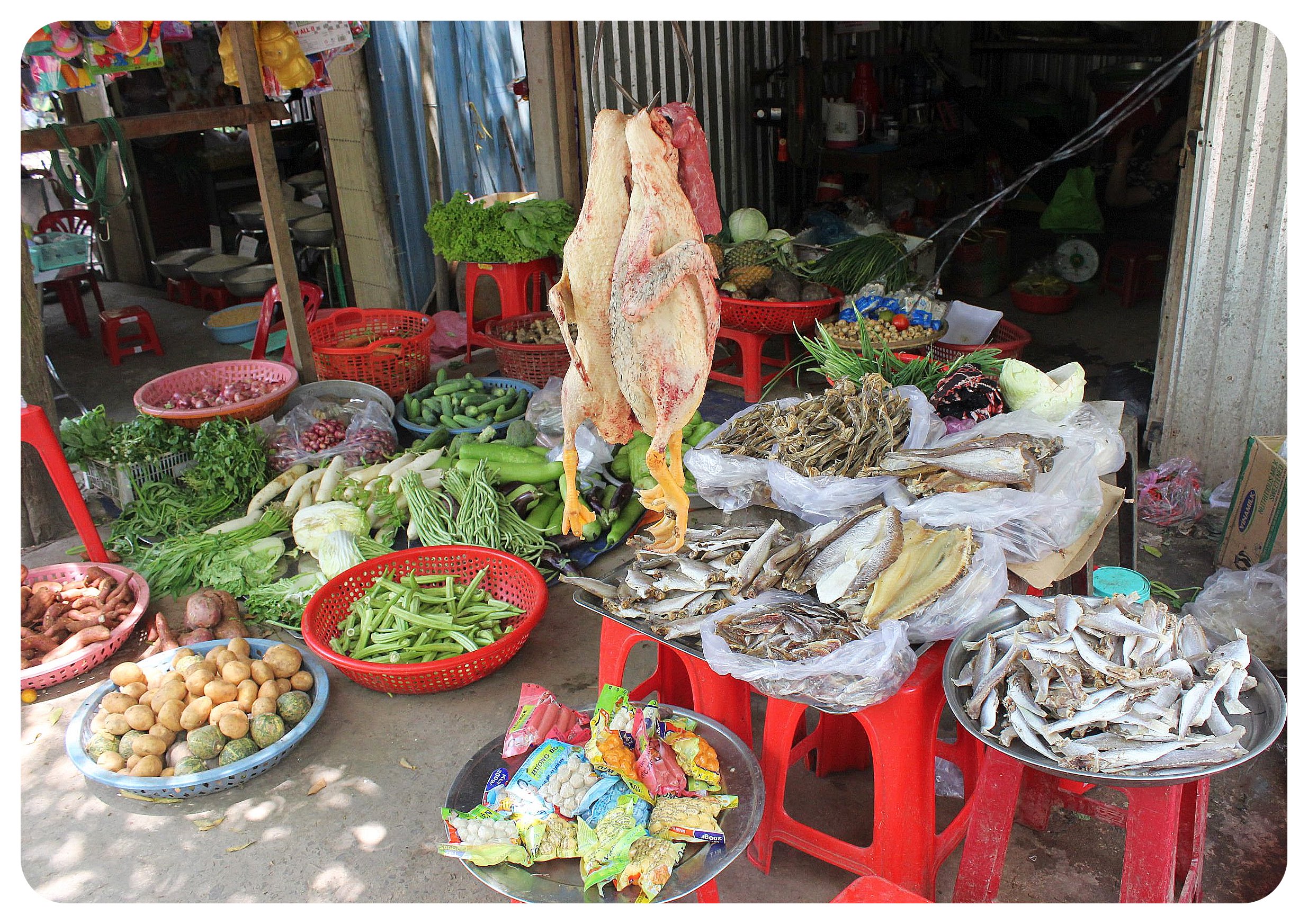 This part of the country is so green and lush that the Mekong Delta is in fact called “Vietnam’s Rice Bowl”: this region provides one third of Vietnam’s food crop!
This part of the country is so green and lush that the Mekong Delta is in fact called “Vietnam’s Rice Bowl”: this region provides one third of Vietnam’s food crop! By the end of the day, I had cycled over 20 miles and crisscrossed the network of canals near Ben Tre in nearly 100° Fahrenheit heat – I was sweaty and dirty, but everything I saw on my bike ride was exactly what I’d hoped for.
By the end of the day, I had cycled over 20 miles and crisscrossed the network of canals near Ben Tre in nearly 100° Fahrenheit heat – I was sweaty and dirty, but everything I saw on my bike ride was exactly what I’d hoped for.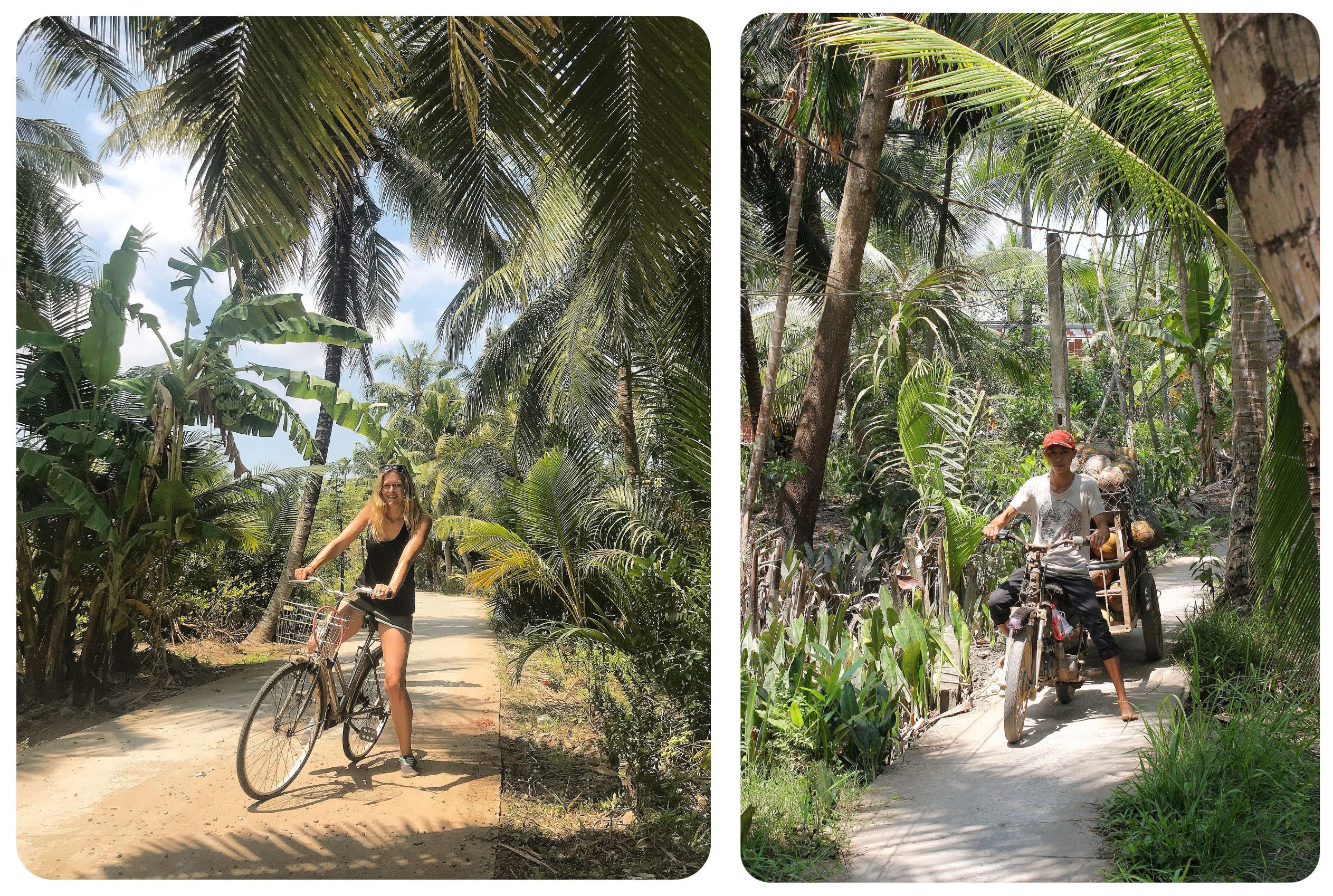 I finished the day with a beautiful sunset over the Ham Luong River, a branch of the Mekong River in the Bến Tre Province.
I finished the day with a beautiful sunset over the Ham Luong River, a branch of the Mekong River in the Bến Tre Province.
I thought that the Mekong Delta was an incredibly special place – not just compared to other places in the world, but also compared to other places in Vietnam. The country is developing so quickly, the cities are changing so drastically, becoming more modern and fast-paced. And even though the Mekong Delta is changing, too, with new bridges being added constantly, you can still get a glimpse of traditional village life, and you can still experience a simpler life, much slower than life in Vietnam’s hectic cities. Should you visit the Mekong Delta? Absolutely!

How to visit the Mekong Delta
Day Trips to the Mekong Delta from Ho Chi Minh City
The easiest way to visit the Mekong Delta is taking a day trip from Ho Chi Minh City – especially if you don’t have a lot of time. However, I highly recommend seeing the Mekong Delta from both land and water – because they provided two vastly different perspectives.
If you’re strapped for time and you can only do a day trip from Ho Chi Minh City, all of these are good options – decide what’s most important to you when picking the right tour for you: A rowboat excursion? A floating market? A small group? Kayaking?
Note that visiting Cai Rang Floating Market on a 1-day trip from Ho Chi Minh City, because the market takes place very early in the morning and closes around 8 – 8.30am. It takes about 3.5 hours to get from Ho Chi Minh City to Can Tho, plus another 40 minutes on the boat to the Floating Market.
Mekong Delta from Ho Chi Minh City in 1 day
- Mekong Delta Tour W/ Row-Boat, Kayak & Small Floating Market (US$35)
- Mekong Delta Small Group W/ Vinh Trang Pagoda & Rowing Boat (US$18.39)
- Ho Chi Minh City: Mekong Delta Day Tour to My Tho & Ben Tre (US$13.59)
- From Ho Chi Minh City: Mekong Delta Luxury 1-Day Group Tour (US$13.91)
- Ho Chi Minh: Mekong Delta Discovery Tour incl boat ride (US$28)
- Mekong Delta Premier Tour with Coconut Village & Kayaking (US$52)
- Private Cai Be Floating Market Tour from Ho Chi Minh City (US$128.90)
Mekong Delta from Ho Chi Minh City 2 – 3 days
If you have a few days and you’d like to do an organized tour from Ho Chi Minh City, here are a few good options:
How to get to the Mekong Delta independently
It’s easier to visit the Mekong Delta with a tour, but of course you can visit the region independently – and if you want to spend more time in the Mekong Delta and explore several places, I recommend taking the bus from Ho Chi Minh City.
There are regular buses from Ho Chi Minh City to all Mekong Delta cities:
- Ho Chi Minh City – Ben Tre: 2 hrs 15 mins (VND80,000)
- Ho Chi Minh City – Vinh Long: 3 hours (VND105,000)
- Ho Chi Minh City – Can Tho: 3.5 hours (VND110,000)
You can see departure times and book your seat online at 12go.com.
Local Mekong Delta Tours
Cai Rang Floating Market from Can Tho
Mekong Tours, a local tour operator in Can Tho, offers two options for guided tours:
- Can Tho Floating Markets (Cai Rang and Phong Dien) and Gardens, 7 hours (US$47)
- Cai Rang Floating Market Tour, 3 hours (US$29)
If you walk down to the pier, you can hire a boat at Can Tho Travel Service Center (it’s on GoogleMaps as Can Tho Tourist) to take you to the markets. Be aware that they usually don’t come with a guide though, only with a Vietnamese-speaking driver. They offer three options – use these prices for your negotiations:
- a 3-hour tour to Cai Rang Floating Market + fruit gardens is around VND360,000 per boat
- a 4-hour tour to Cai Rang Floating Market + river canals is around VND550,000 per boat
- a 4-hour tour to Cai Rang Floating Market + Phong Dien Floating Market is around VND550,000 per boat
Can Tho Food Tour
- Can Tho Food Tour – Pay What You Like at the end of the tour ($US 5 recommended)
Can Tho Bicycle Tour
- Can Tho Bicycle Tour – 3-hr bike ride in the countryside (US$19.50)
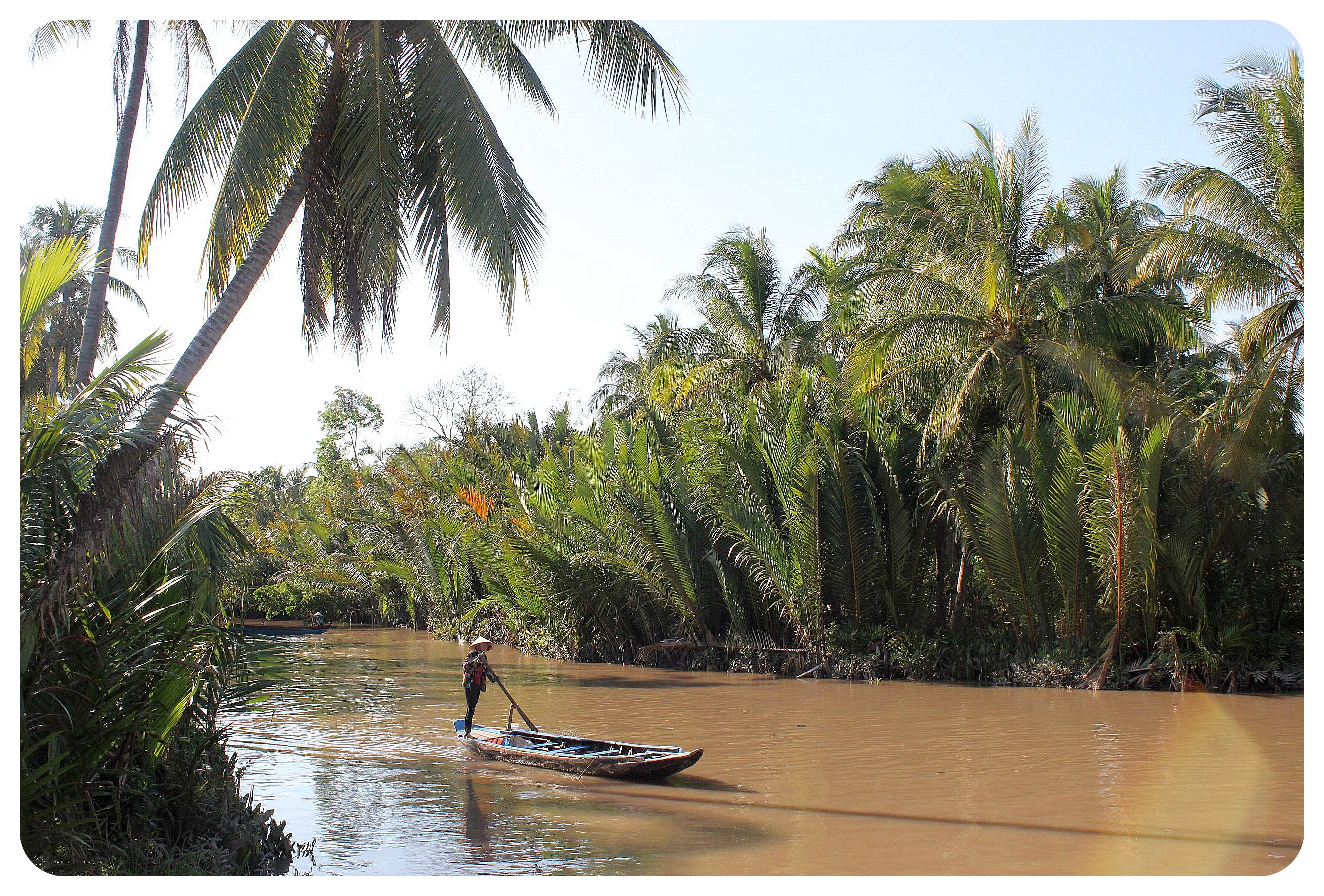
The best homestays in the Mekong Delta
Of course there are hotels and resorts in this region, but I recommend staying in a homestay when you visit the Mekong Delta – at least for a couple of nights. Here are the best ones in the area:
Ben Tre Area
- Mini Mekong Homestay (US$18 per night, breakfast included)
- Coco land Homestay Ben Tre (US$23 per night, free bicycle use and breakfast included)
- Nguyet Que Homestay – near Ben Tre (US$19 per night, including breakfast)
- Quoc Phuong Riverside Homestay with swimming pool – near Ben Tre (US$15 including breakfast)
- Ba Danh Home – near Ben Tre (US$14 per night, free bicycles and breakfast included)
- Ben Tre Stay (US$8 per night, breakfast and free bicycle use included)
Can Tho Area
- Queenie House – small family-run hotel / home stay (US$21 per night)
- Farmer Homestay – small bamboo cottages on the outskirts of Can Tho (US$36 per night, including breakfast)
- Boutique Lodge Can Tho Homestay – near Can Tho (US$39 per night, breakfast included)
- Can Tho Ecolodge – near Can Tho, featuring free bicycles, outdoor swimming pool and a garden (from US$65 per night, including breakfast)
- Binh Minh Eco Lodge – beautiful eco-lodge with swimming pool near Can Tho, right on the river (from US$91 per night, breakfast included)
Vinh Long Area
- Jardin du Mekong – an eco-home stay in Vinh Long (30 mins by boat from Cai Be Floating Market) with bungalows from US$62 per night, including breakfast and dinner


